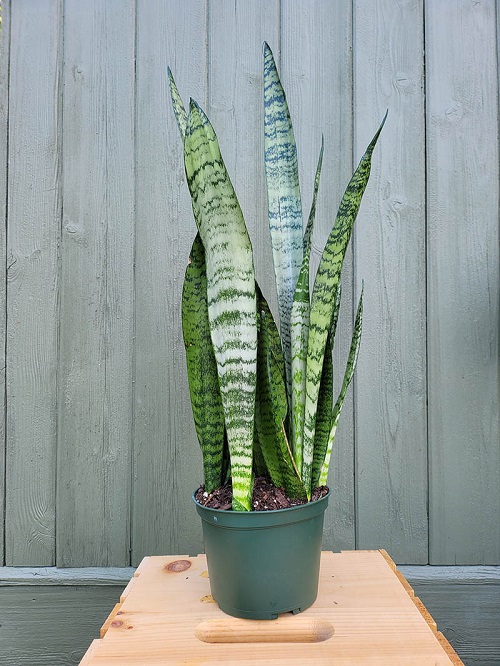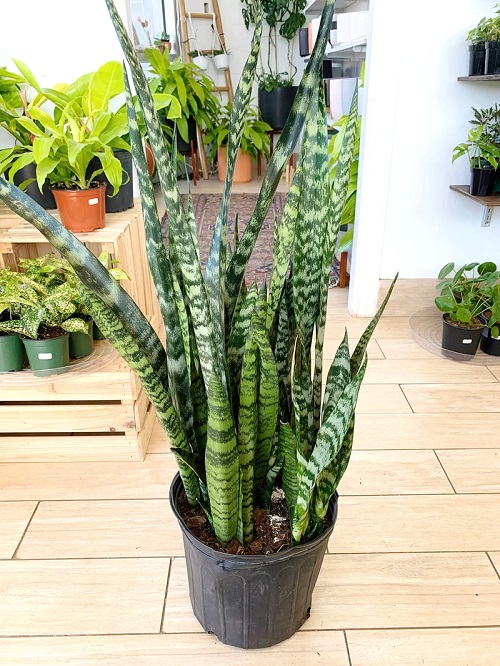Sansevieria Wintergreen is a compact specimen that stands out with its black-green foliage. Here’s everything about growing it!
Sansevieria Wintergreen is a snake plant with a twist – thanks to its dark foliage that sets it apart from other houseplants. Here are all the details about growing it.
Botanical Name: Sansevieria trifasciata ‘Wintergreen’
USDA Zones: 9-11
Other Names: Wintergreen Snake Plant, Wintergreen Mother-in-Law’s Tongue
Learn about Whale Fin Sansevieria Care here
Sansevieria Wintergreen Plant Information
Sansevieria Wintergreen is a striking succulent native to West Africa. With its long, sword-shaped leaves, it exhibits a distinctive appearance that sets it apart from other houseplants. The leaves of Sansevieria Wintergreen are upright, stiff, and can grow quite tall, forming a dense rosette-like arrangement.
One of the notable characteristics of Sansevieria Wintergreen is its ability to tolerate a wide range of light conditions. It can thrive in both bright, indirect light, and low-light environments, making it an excellent choice for indoor spaces with varying lighting conditions.
Sansevieria Wintergreen is also revered for its hardiness and resilience. It is a drought-tolerant plant, capable of surviving extended periods without water. This adaptability, along with its low maintenance requirements, makes it an ideal choice for beginner gardeners or those with busy lifestyles.
Fact: This plant is renowned for its air-purifying properties, as it efficiently removes toxins from the surrounding atmosphere, contributing to improved indoor air quality.
Check out the best Types of Snake Plant Varieties to Grow Indoors here
How to Grow Sansevieria Wintergreen?
Division:
- Select a mature plant with multiple healthy leaves and rhizomes.
- Carefully remove the plant from its pot and gently separate the rhizomes or offsets from the main plant.
- Ensure that each division has a healthy root system and a few leaves.
- Plant the divisions in separate pots filled with well-draining soil mix, burying the rhizome or offset and setting the leaves above the soil surface.
- Water the newly potted divisions and place them in a bright, indirect light location. Allow the soil to dry out slightly between waterings.
Leaf Cuttings:
- Choose a healthy, mature leaf from the plant.
- Cut the leaf into sections that are around 2-3 inches (5-7.5 cm) long. Make sure each section has a small portion of the base intact.
- Lay the leaf sections horizontally on a tray or plant them directly into a well-draining potting mix.
- Water the cuttings lightly and place them in a warm location with indirect light.
- New shoots should emerge from the base of the leaf sections, eventually developing into new plants.
- Once the new plants have grown sufficiently, they can be transplanted into individual pots.
Here are 12 Simple Seed Germination Tips To Grow Every Seed
Plant Pot Size for Sansevieria Wintergreen
When selecting a pot size for your Sansevieria Wintergreen, opt for a pot that is slightly larger than the current root ball.
You can start the plant in an 8-12 inches container, which will be good for a few years. Based on its growth and spread, keep on re-potting it into one size bigger container than the old one.
Here are Plant Pot Sizes from Inches to Gallon
Requirements for Growing Sansevieria Wintergreen
Sunlight
Sansevieria Wintergreen thrives in a variety of light conditions, ranging from bright indirect light to low light. It can tolerate both shade and direct sunlight, although prolonged exposure to intense sunlight may cause leaf burn.
Place your Sansevieria Wintergreen in a location that receives moderate to bright light for a few hours a day, such as near a north or east-facing window. The plant can also adapt to low-light environments, making it suitable for offices or rooms with limited natural light.
Soil
Sansevieria Wintergreen prefers a well-draining potting mix. A mixture of peat moss, perlite, and coarse sand works well to provide good drainage and prevent waterlogged roots. Avoid using heavy or compacted soils, as they can lead to root rot.
Here are the TOP Snake Plant Soil Recipes for Fantastic Growth
Water
Sansevieria Wintergreen is relatively drought-tolerant and is more susceptible to overwatering than underwatering. Allow the soil to dry out partially between waterings. Water thoroughly, ensuring the excess water drains out of the pot.
During the winter months or when the plant is in a period of dormancy, reduce the watering frequency to avoid waterlogged conditions.
Learn How Often to Water a Snake Plant here
Temperature & Humidity
Sansevieria Wintergreen prefers average to warm temperatures. It thrives in temperatures between 70-90°F (21-32°C) during the growing season. It can tolerate slightly cooler temperatures down to 55°F (13°C).
However, it’s best to avoid exposing the plant to temperatures below 50°F (10°C) for extended periods, as it may lead to damage or slowed growth.
Sansevieria Wintergreen is adaptable and can tolerate a wide range of humidity levels too. It can thrive in both dry and moderately humid environments, making it suitable for various indoor conditions. However, it generally prefers average indoor humidity levels between 40-60%.
Check out 10 Ways To Increase Humidity For Houseplants That Work here
Sansevieria Wintergreen Care
Fertilizer
Fertilizing Sansevieria Wintergreen is generally not necessary, as it is a low-maintenance plant that can survive in nutrient-poor conditions. However, if you choose to fertilize, do so sparingly.
Apply a balanced, water-soluble houseplant fertilizer diluted to half strength during the growing season (spring and summer) every two to three months. Avoid fertilizing during the dormant period (fall and winter) as the plant’s nutrient requirements are lower.
Want to Make Organic Fertilizers from Kitchen Scraps? Click here
Pruning
Pruning requirements for Sansevieria Wintergreen are minimal. Remove any yellowed, damaged, or dead leaves by cutting them off at the base with clean pruning shears. Pruning can also be done to control the size or shape of the plant if desired.
However, keep in mind that Sansevieria Wintergreen has a slow growth rate, and pruning is generally not necessary. You can do it for aesthetic purposes or to manage the plant’s size.
Pests and Diseases
Sansevieria Wintergreen is known for its resistance to most pests and diseases. However, it can occasionally encounter issues with common houseplant pests such as spider mites and mealybugs.
Regularly inspect the plant for any signs of infestation, such as webbing, tiny insects, or white cottony masses. If pests are detected, isolate the affected plant and treat it with an appropriate insecticidal soap or horticultural oil.
Sansevieria Wintergreen is relatively resistant to diseases. However, overwatering or poorly drained soil can lead to root rot or fungal diseases.
To prevent these issues, ensure the soil is well-draining and avoid overwatering. If you notice signs of root rot, such as yellowing, mushy roots, or a foul odor, take immediate action by adjusting the watering and improving drainage conditions.






